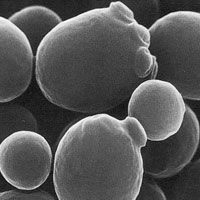Yeasts

Fig. 1: Common baker's yeast, Saccharomyces cerevisiae.
Image courtesy Alan Wheals, University of Bath, UK.
INDISIM-YEAST models the evolution of the yeast population over a period of time in the bulk of a liquid medium occupying a three dimensional spatial grid. The simulated cellular cycle assumes, in accordance with experiment, that yeast cells undergo budding reproduction; that budding leaves scars in each cell; and that cells divide unequally. Moreover, the simulator takes into account the effects arising from bud scars; the growth arrest resulting from the metabolite ethanol, a fermentable sugar, glucose; and the excess of nutrient concentration. Since the model is still very complex, it is simplified by assuming that the cellular cycle, for each cell, only involves two clearly differentiated phases or intervals. Simulations were carried out for population averaged properties (global properties), as well as for those properties that pertain to individual yeast cells involving both timevolving and population parameters. In spite of the important simplifications introduced in the simulations the results are in good qualitative agreement with the experimental trends, excluding the oxidative consumption of ethanol which has not been modelled in our first INDISIM-YEAST simulator.

Fig. 2: Yeast from http://www.ipb-halle.de/ipb/user/tfester/english/beer/ingreds/yeast.htm
We present results of simulations that model the time evolution of "global" magnitudes of the yeast culture, such as nutrient (glucose), residual product (ethanol), biomass, and total number of viable cells. We also report results of simulations
i) for the distributions of masses and genealogical age of the yeast cells at different states of the colony growth (lag phase, exponential growth, linear phase, metabolic slow down, final stage with a total stop in the activity of the population),
ii) of the time spanned by the different phases in the cellular cycle, as well as
iii) the biomass for each of these phases as a function of the generalized age of the yeast cells.
INDISIM-YEAST can also provides clear insights into metabolic oscillations, which we relate to metabolic inhibitions in the system. The fluctuations of heat dissipation basically reflect the catabolic activity during the different phases of the system. Microcalorimetry experimental power-time (p-t) curves are reported for two strains of the yeast S. cerevisiae under batch conditions. Both curves exhibit high frequency oscillations in the longer times of these curves, corresponding to times when the yeast culture shows a progressive slowdown of metabolic activity. The origins of these oscillations are studied by using INDISIM-YEAST. The simulations suggest that the oscillations are due to the inhibition experienced by each individual cell due to the presence of ethanol. In the simulations the inhibiting mechanism is discrete and does not necessarily involve all of the yeast population cells.
The simulator INDISIM-YEAST cannot account for yeast flocculation directly. This is the phenomenon of spontaneous cellular aggregation to form reversible macroscopic flocs. In brewing yeasts -for instance S. cerevisiae and S. carlsbergensis- flocculation appears when primary fermentation is almost completed. A very simple adaptation of INDISIM has been performed to account for this phenomenon and it has been used to examine the predictions of two different models of yeast flocculation. The first, proposed by Calleja (1987), is known as the "addition" model. The second, proposed by Stratford (1992) is known as the "cascade" model. The simulations show that the latter exhibits a better qualitative agreement with available experimental data.

Fig. 3: Flocculation yeast from http://www.uovs.ac.za/fac/natural_agricultural/micro/mkboc/lipid/
INDISIM-YEAST, an individual-based simulator to study yeast populations in liquid media
aneto.upc.es/simulacio/hoja-portada.html
Related publications
Related conferences
Share: